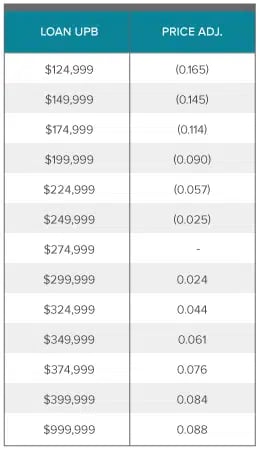Surprises aren’t always welcome. A “just because” gift or complimentary piece of dessert may delight someone when delivered without notice, but balance sheet surprises are another story.
Yet, as mortgage servicing rights (MSR) continue to occupy larger portions of accounting books across the mortgage banking industry, many lenders are coming to the realization that they don’t have a consistent, accurate grasp on the value of their MSR assets. Servicing grids have long been the standard for valuing MSR assets in between period-end reporting and prior to loan sale. However, the values produced via these grids lack the granularity of those formulated by MSR brokers via cash flow engines – the values that ultimately land on the accounting books.
To demystify the loan-level value of MSR assets, maximize profitability, and avoid the reporting surprises increasingly seen over the last 18 months given market volatility, it’s timely and appropriate for lenders to assess their current approach to MSR valuation and consider pivoting to a more dynamic model.
The Shortcomings of Servicing Grids
MSR assets are highly rate sensitive, and as such it’s critical to monitor them actively in order to inform strategic retain/release decisioning and remain informed between period-end reporting. Historically, mortgage lenders have relied on simplified servicing grids for point-in-time MSR values between period-end reporting, at which time they would obtain more accurate values from MSR brokers.
While common and easy to understand, servicing grids are static, as they are only updated monthly or quarterly. MSR valuations require complex modeling and reliance on assumptions and estimates. Given the illiquidity of MSR assets, mispricing them can result in added risk and lost revenue. Nonetheless, most lenders are still using grid-based pricing to determine MSR values for origination, mark-to-market and loan sales. The reality is that retain/release decisioning can come down to just one or two basis points – a nuance that a grid won’t necessarily detect. Additionally, the capitalization value of an MSR can differ from the monthly valuation from a third party, leading to accounting problems down the road.
The challenge with grids is that most loans do not fall directly on the grid line, but instead somewhere in between. For example, if a grid breaks down adjustments applied to servicing rights by $100,000 increments, it does not precisely tell you what happens with a $250,000 loan that falls between the tiers.
Beyond unwelcomed accounting surprises, pricing irregularities can cause lenders and servicers to leave considerable money on the table. Without understanding the different parameters driving servicing values, lenders may not price loans correctly, and thus may fail to incentivize production that supports their business goals. Retaining the wrong loan can lead not only to poor MSR valuations in the future, but also to cash mistakenly tied up in potential advances or early buyouts. Servicers could, theoretically, be overpaying upfront for a loan and inadvertently capitalizing the asset at a different value than what an MSR broker would value that asset in the future.
The Advantages of a Cash Flow Model
Fortunately, lenders have an alternative to generic servicing grids. By using broker assumptions and an advanced cash flow model, lenders can fine-tune MSR valuations and access a more precise version of this data daily, rather than waiting until month-end reporting. Leveraging a cash flow model with broker-managed assumptions can help lenders boost financial performance and competitiveness, while gaining transparency that supports more strategic retain/release decisioning. Additionally, thanks to the increased accuracy and granularity of a cash flow-based model with broker-managed assumptions, lenders can expect to receive better duration predictions, which can help improve hedging performance.
Cash flow-based pricing is sometimes associated with more sophisticated lending pipelines, but on an increasing basis, lenders of all sizes and experience levels are wisely choosing this more granular method over grids. Since cash flow values are based off loan-level characteristics and broker-managed assumptions, they enable lenders to price each loan individually and avoid getting stuck between buckets in a grid. The more accurate duration profile produced by cash flow-based models and broker-managed assumptions will help decrease any disconnects on hedge performance as rates move during the pipeline hedging period.
When running a discounted cash-flow analysis, a lender uses broker assumptions to form projections for every month in the future that it will service the loan – including the costs associated with doing so and the value to be gained from retaining the loan. These various cash outflows and inflows are projected out for the term of the loan and then discounted back to a present-day value to form a loan-level, cash-flow value. This model is more defensible than grid-determined value and can prevent inaccurate pricing and poor retain/release decisions. And, best of all, this more precise valuation information is accessible on a daily basis – no waiting, and no surprises at period-end since the same broker assumptions are being used.
Crunching the Numbers
Let’s take a deeper dive into the benefits of cash flow-based pricing over servicing grid pricing. Below, an example of an MSR grid is provided to account for loan amount. As you see, the grid is organized in $25,000 increments, which means loans that fall between increments receive the same adjustment based on loan amount.

To compare the difference between a cash flow with broker assumptions and a grid-based value, let’s consider a scenario with a $305,000, 3% conventional 30-year loan.
Based on grids, the starting value begins at 56.7 basis points, plus 4.4 basis points of a loan amount adjuster, for a total of 61.1 basis points ($1.86K). The cash flow valuation based on broker assumptions derives a value of 59.6 basis points ($1.81K) for a difference of approximately 1.5 basis points and a 2.5% error percentage.
As mentioned, loan sales and the retain/release decision commonly come down to mere basis points. From an origination standpoint, this difference means that this type of loan is being priced too high and incentivizing more of this production, which may not be in line with larger company strategies.

It’s time to take the ambiguity out of MSR valuation by adopting a loan-level, cash flow model. Don’t sacrifice profitability and compromise strategic decisioning any longer. By taking steps toward a more accurate alternative over servicing grid pricing today, you can avoid balance sheet surprises tomorrow.
Ready to get started with cash flow pricing? Black Knight’s MSR PlatformSM can help support your success with a variety of delivery options and direct integrations to leading MSR brokers. Email AskBlackKnight@BKFS.com to learn more.
